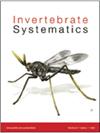Hiding among the palms: the remarkable discovery of a new palm bug genus and species (Insecta: Heteroptera: Thaumastocoridae: Xylastodorinae) from remote Norfolk Island; systematics, natural history, palm specialism and biogeography
IF 1.9
2区 生物学
Q3 EVOLUTIONARY BIOLOGY
引用次数: 0
Abstract
ABSTRACT The discovery of a remarkable new palm bug species on Norfolk Island brings into question its systematic position within the family Thaumastocoridae, and the validity and biogeography of the three extant subfamilies. Latebracoris norfolcensis gen. nov., sp. nov. is described from remote Norfolk Island in the Southwest Pacific. The species was found on the native Norfolk Island palm Rhopalostylis baueri. The formal description of the species includes fine details of external non-genitalic and genitalic characters, supported with images from light and scanning electron microscopy. Details of the egg are described, including the shape and micropylar configuration. All nymphal stages are diagnosed morphologically and morphometrically, with the segregation of the five instars using the Brooks–Dyar Rule. The natural history of the Norfolk Island Palm Bug is documented, including the oviposition site of eggs, and microhabitat of nymphs and adults on palm infructescences, with hypotheses about development in relation to reproductive succession of the palm host. The systematic position of the Norfolk Island Palm Bug is assessed through a phylogenetic analysis of a selection of taxa of the superfamily Miroidea, using the parsimony criterion. The phylogenetic analyses were partitioned into Recent and fossil taxa, revealing monophyly of the Thaumastocoridae, and the subfamilies Thaumastocorinae and Xylastodorinae, with synapomorphy and significant resampling support. The Thaicorinae are verified as synonymous with the Xylastodorinae. The monotypic fossil subfamily Thaumastotinginae is removed from the Thaumastocoridae and treated as incertae familiae. Suprageneric relationships were corroborated in the two taxon partition analyses. An overview of host associations is given verifying palm specialism for the Xylastodorinae. The natural history, palm specialism, biogeography, morphology and systematics of the Xylastodorinae and allies are discussed in light of the discovery of Latebracoris norfolcensis. ZooBank: urn:lsid:zoobank.org:pub:40A20DE4-6489-4B67-BF2E-0B7256BA1CD1隐藏在棕榈丛中:在遥远的诺福克岛发现了一种新的棕榈虫属和种(昆虫纲:异翅目:掌蝽科:木蝽科);系统学、自然史、棕榈学和生物地理学
在诺福克岛发现了一种引人注目的棕榈虫新物种,这使人们对它在棕榈虫科中的系统位置以及现存的三个亚科的有效性和生物地理学产生了疑问。norfolcensis latebroris gen. nov., sp. nov.被描述为西南太平洋偏远的诺福克岛。该物种是在诺福克岛本地棕榈树Rhopalostylis baueri上发现的。该物种的正式描述包括外部非生殖器和生殖器特征的精细细节,并附有光学和扫描电子显微镜的图像。描述了蛋的细节,包括形状和微孔结构。所有的若虫阶段都是用形态学和形态计量学来诊断的,用布鲁克斯-戴尔规则对五个阶段进行分离。本文记录了诺福克岛棕榈虫的自然历史,包括卵的产卵地点、若虫和成虫在棕榈枝上的微栖息地,以及棕榈寄主生殖演替的有关发育的假设。诺福克岛棕榈虫的系统位置是通过一个选择的分类群的系统发育分析,使用简约标准的超家族的Miroidea评估。系统发育分析结果表明,该植物可划分为近代和化石分类群,并可划分为同源性较强的Thaumastocorinae亚科和Xylastodorinae亚科。泰科被证实与木茄科同义。单模化石亚科Thaumastotinginae从Thaumastocoridae中分离出来,作为跨科处理。超属关系在两个分类单元划分分析中得到证实。宿主协会的概述给出验证棕榈专为木茄科。本文以诺folcenlatebroris norfolcensis的发现为背景,讨论了木茄科及其同属植物的自然史、棕榈特征、生物地理学、形态学和系统学。ZooBank: urn: lsid zoobank.org:酒吧:40 a20de4 - 6489 - 4 - b67 bf2e - 0 - b7256ba1cd1
本文章由计算机程序翻译,如有差异,请以英文原文为准。
求助全文
约1分钟内获得全文
求助全文
来源期刊

Invertebrate Systematics
生物-动物学
CiteScore
4.30
自引率
9.10%
发文量
35
审稿时长
>12 weeks
期刊介绍:
Invertebrate Systematics (formerly known as Invertebrate Taxonomy) is an international journal publishing original and significant contributions on the systematics, phylogeny and biogeography of all invertebrate taxa. Articles in the journal provide comprehensive treatments of clearly defined taxonomic groups, often emphasising their biodiversity patterns and/or biological aspects. The journal also includes contributions on the systematics of selected species that are of particular conservation, economic, medical or veterinary importance.
Invertebrate Systematics is a vital resource globally for scientists, students, conservation biologists, environmental consultants and government policy advisors who are interested in terrestrial, freshwater and marine systems.
Invertebrate Systematics is published with the endorsement of the Commonwealth Scientific and Industrial Research Organisation (CSIRO) and the Australian Academy of Science.
 求助内容:
求助内容: 应助结果提醒方式:
应助结果提醒方式:


